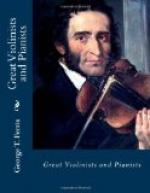III.
Love-making was also among the diversions which Paganini began early to practice. Like nearly all great musicians, he was an object of great fascination to the fair sex, and his life had its full share of amorous romances. A strange episode was his retirement in the country chateau of a beautiful Bolognese lady for three years, between the years 1801 and 1804. Here, in the society of a lovely woman, who was passionately devoted to him, and amid beautiful scenery, he devoted himself to practicing and composition, also giving much study to the guitar (the favorite instrument of his inamorata), on which he became a wonderful proficient. This charming idyl in Paganini’s life reminds one of the retirement of the pianist Chopin to the island of Majorca in the company of Mme. George Sand. It was during this period of his life that Paganini composed twelve of his finest sonatas for violin and guitar.
When our musician returned again to Genoa and active life in 1804, he devoted much time also to composition. He was twenty years of age, and wrote here four grand quartets for violin, tenor, violoncello, and guitar, and also some bravura variations for violin with guitar accompaniment. At this period he gave lessons to a young girl of Genoa, Catherine Calcagno, about seven years of age; eight years later, when only fifteen years old, this young lady astonished Italian audiences by the boldness of her style. She continued her artistic career till the year 1816, when she had attained the age of twenty-one, and all traces of her in the musical world appear to be lost; doubtless, at this period she found a husband, and retired completely from public life.
In 1805 Paganini accepted the position of director of music and conductor of the opera orchestra at Lucca, under the immediate patronage of the Princess Eliza, sister of Napoleon and wife of Bacciochi. The prince took lessons from him on the violin, and gave him whole charge of the court music. It was at the numerous concerts given at Lucca during this period of Paganini’s early career that he first elaborated many of those curious effects, such as performances on one string, harmonic and pizzicato passages, which afterward became so characteristic of his style.




